Those of you who were followers of my earlier blog angela in provence may remember that, fed up with all the snails in my courtyard, I attempted the traditional French way of dealing with the pests; turning them into dinner. I wasn’t very successful (they all got away). So when I saw a sign, outside Saint Remy, for a snail farm, I thought I’d go and see how the professionals do it.

I phone the owner of the farm, or rather héliciculteur, who is called Alphonse de Meis and he very kindly agrees to show me round. It is after 7 when I arrive, feeding time, and we go into the field beside his house which is blooming with poppies at this time of year. It looks like an idyllic, rural Provençal scene. Within the field are large areas that have been enclosed with low corrugated metal walls with an electric wire along the top. These are the snail pens, and the electric wire is to keep the snails inside the pens, as well as to keep predators, hedgehogs, porcupines and rats, out.

M. de Meis slings a plastic container round his neck and fills it with organic snail food, which he scatters over wooden boards running the length of the pens in between rows of rosemary, grass, thistles and various other plants that snails like. So far I haven’t seen very many snails. However after he has distributed the food, and the water sprinklers have been on for a while, the snails start to appear, apparently enticed by the moisture and the smell of the food.

M.de Meis rears two types of snails, which he keeps in separate pens. One is Le Petit Gris (Helix Aspersa Müller) which is small and indigenous to Provence and Le Gros Gris, (Helix Aspersa Maxima) which originate from Algeria. The Petit Gris is cooked and eaten out of its shell, whereas the Gros Gris is most commonly used for its meat only and prepared out of the shell.
The snails stay outdoors in the pens for all of their growing, or fattening up time, which for the Petits Gris is 90 days and for the Gros Gris is 120. On reaching maturity the snails start to mate and it is at this point that they are collected. The choicest snails are kept for re-producing and go to a cold room where they are put into hibernation over the winter. The rest are starved for a week, to purge them of any bitterness, and then sent off to a special laboratory where they are cooked under special, supervised, conditions and then put into jars ready to be sold.
When the feeding is done (this takes roughly an hour) M. de Meis takes me into the spawning shed behind his office. This is where the snails are brought in the spring to wake up from their hibernation, to copulate and lay their eggs. It is warm and humid and the room seems to be moving with the slow motion of writhing snails covering every inch of the wooden shelves. There is a fetid smell and my first reaction is one of repulsion; I want to flee.
Snails are hermaphrodites, they have both male and female sex organs, but they do not self fertilise and so have to fertilise each other’s eggs. M.de Meis points out to me a couple in the early stages of ‘getting in on’, the snails are entwined around each other and one snail has a dart in its head. Shooting each other with a ‘love’ dart (made of calcium) sexually stimulates them and starts the whole thing off (this may be where the Greek myth of Cupid’s arrow originates from).
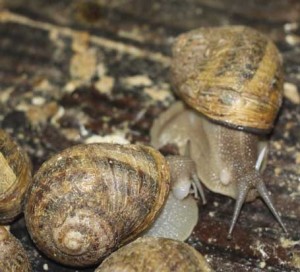
M de Meis points out another couple that are in the process of transferring sperm to each other, he picks them up to show me. There is something quite gross and yet at the same time quite fascinating about seeing such a graphic display of a snail’s sex life.
10 days after the coupling, which can take up to 10 hours (well they only do it once, so they might as well make the most of it), they lay their eggs into nesting trays. Each snail lays around 100 eggs, which M. de Meis then collects and puts into plastic boxes to incubate. Eight days after the snails emerge from their eggs, they are transferred outdoors into the snail pens.
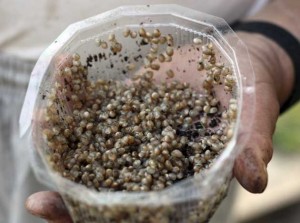
It seems that the rearing of snails, escargots, cagouilles or hélix (how many names do they have?) is a very serious business. 35 – 40,000 tons of snails are consumed in France but only 1,000 tons are farmed here, the rest are foraged or imported from Eastern Europe or Turkey.
M de Meis is not certified organic, but doesn’t use any pesticides in the fields and only feeds the snails organic feed. Snails absorb and retain pesticides and therefore, even if they are collected in the wild, can be found to have as many as 15 different toxic chemicals in their bodies.
At the end of the visit, we go into his office where he sells his snails. There are some in the freezer prepared in the way we know best, with butter, parsley and garlic, but there also jars of snails on shelves that he has prepared himself and cooked in a court-bouillon, in a tomato sauce, a spicy sauce, with cèpes, with girolles, there is even a snail butter spread for toast! I buy a jar of snails in bouillon and a jar of his homemade Provençal sauce and thank him for the visit. M. de Meis tells me he often has summer soirées in his field and he promises to invite me when he next hosts one. No prizes for guessing whats on the menu!
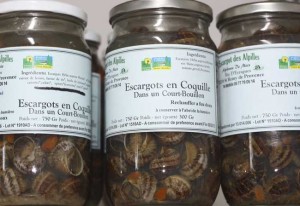
Later I cook the snails for The Artist and Fred, our French neighbour, for his approval. I heat up the snails in their bouillon and add them to the Provençal tomato sauce. I then cook up some fresh pasta and serve the sauce with the pasta. Fred gives it his authentication; they taste just like grandmère’s used to!
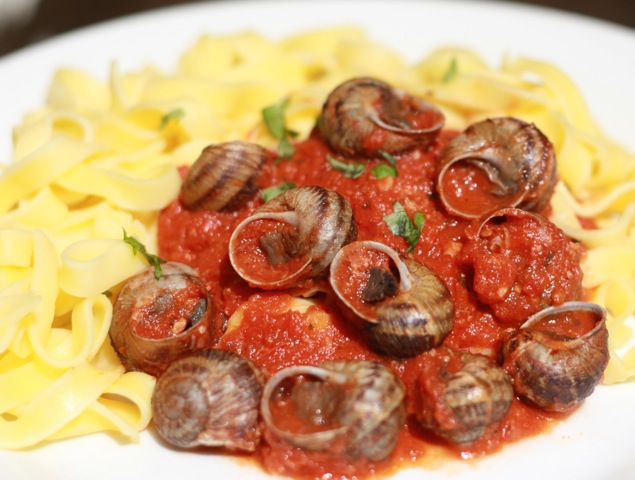
For more reading on snail farming and recipes you can go to the French site http://heliciculture.escargot-blond-des-flandres.com/index.php.
If this story has affected you in any way, please leave a comment, by clicking on the word ‘comment’ below.
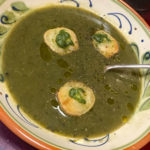















Hi Angela,
This is simply fascinating, thank you! My colleague Hank tried to harvest snails from the ones he picked from my yard last year, but apparently they all died. I’ve read about other people here putting them into a bucket of corn meal for a month to clean out their intestines. Oddly while I love escargot, the idea of trying to raise the snails myself for this purpose is … well, I just don’t have any desire to do it. If you get a chance, rent the DVD “microcosmos”. There’s an amazing scene of snails mating. Beautiful actually.
This post is very timely for me as I’m currently endeavoring to capture & mature snails in my own garden in Washington state. Happy to see I’m on the right track with my outdoor pen, but think I’ll forego the electric wire this go-round. Oh, & if men only mated for as long as the snails, I would be a very happy girl.
Fascinating and slightly creepy (or slimy). It reminds me of going out with a torch and a bucket of salty water to pick the buggers off my veg garden in Farnham which is surely the capital of Snaildom. I can’t mentally get past the slime aspect or I could have made a living from bottling them! Thanks, Angela !
i just learned about twitter today…in bed with laptop and bum leg…this is my first reading and so so interesting..now i am fascinated and hungry…when you say the petites are eaten from the shell, is it their original shell or are they removed and the shell cleaned and put back ? your pic is beautiful, any othr great recipe ideas ?
The smaller snails are cooked in their shells and eaten whole out of the shell. The larger ones are removed from their shells and only the flesh is eaten (not the entire snail). The flesh is sometimes put back in the shell which is then stuffed with garlic and parsley butter.
As usual, I love your post! So fascinating! Thank you so much for sharing, Angela. I recommend your blog more than anyone’s because it’s always so darn interesting! 🙂
I just tasted sea snails for the first time on my trip. Not a convert yet, but your recipe just might bring me around to the other side of the snail equation.
The Helix aspersa (since renamed Cornu aspersum) was introduced to California from France during the 1850s for use as food, but is now the most common snail species bugging shit in local gardens.
:^) No wonder why search engine result advertisement veteran Themelis Cuiper tweeted a link to your piece – so you are doing an excellent job as he provides a link to you.
This was great, Angela! I’m in the beginning steps of starting my own farm in North Carolina. Lots of permitting and legal steps, but this article was pretty darn helpful!